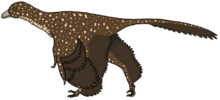| Pedopenna Temporal range: Late Jurassic,
| |
|---|---|

| |
| Reconstruction as an anchiornithid | |
| Scientific classification | |
| Domain: | Eukaryota |
| Kingdom: | Animalia |
| Phylum: | Chordata |
| Clade: | Dinosauria |
| Clade: | Saurischia |
| Clade: | Theropoda |
| Clade: | Paraves |
| Family: | †Anchiornithidae |
| Genus: | †Pedopenna Xu & Zhang, 2005 |
| Species: | †P. daohugouensis
|
| Binomial name | |
| †Pedopenna daohugouensis Xu & Zhang, 2005
| |
Pedopenna (meaning "foot feather") is a genus of small, feathered, maniraptoran dinosaur from the Daohugou Beds in China. It is possibly older than Archaeopteryx, though the age of the Daohugou Beds where it was found is debated. A majority of studies suggest that beds probably date from between the late Middle Jurassic (168 million years ago) and early Late Jurassic Period (164-152 million years ago).[1]
The name Pedopenna refers to the long pennaceous feathers on the metatarsus; daohugouensis refers to the locality of Daohugou, where the holotype was found.[2] Pedopenna daohugouensis probably measured 1 meter (3 ft) or less in length, but since this species is only known from the hind legs, the actual length is difficult to estimate. Pedopenna was originally classified as a paravian, the group of maniraptoran dinosaurs that includes both deinonychosaurs and avialans (the lineage including modern birds), but some scientists have classified it as a true avialan more closely related to modern birds than to deinonychosaurs.[3] More recently, it has been recovered as a scansoriopterygid.[4] Lately it was placed to the family Anchiornithidae.[5]
- ^ Liu Y.; Liu Y.; Ji S.; Yang Z. (2006). "U-Pb zircon age for the Daohugou Biota at Ningcheng of Inner Mongolia and comments on related issues". Chinese Science Bulletin. 51 (21): 2634–2644. Bibcode:2006ChSBu..51.2634L. doi:10.1007/s11434-006-2165-2. S2CID 96442710.
- ^ Xu, X. & Zhang, F. (2005). "A new maniraptoran dinosaur from China with long feathers on the metatarsus". Naturwissenschaften. 92 (4): 173–177. Bibcode:2005NW.....92..173X. doi:10.1007/s00114-004-0604-y. PMID 15685441. S2CID 789908.
- ^ Hone D.W.E.; Tischlinger H.; Xu X.; Zhang F. (2010). Farke, Andrew Allen (ed.). "The extent of the preserved feathers on the four-winged dinosaur Microraptor gui under ultraviolet light". PLOS ONE. 5 (2): e9223. Bibcode:2010PLoSO...5.9223H. doi:10.1371/journal.pone.0009223. PMC 2821398. PMID 20169153.
- ^ Hartman, Scott; Mortimer, Mickey; Wahl, William R.; Lomax, Dean R.; Lippincott, Jessica; Lovelace, David M. (2019). "A new paravian dinosaur from the Late Jurassic of North America supports a late acquisition of avian flight". PeerJ. 7: e7247. doi:10.7717/peerj.7247. PMC 6626525. PMID 31333906.
- ^ Lefèvre, Ulysse; Cau, Andrea; Hu, Dongyu; Godefroit, Pascal (2020), Foth, Christian; Rauhut, Oliver W. M. (eds.), "Feather Evolution in Pennaraptora", The Evolution of Feathers: From Their Origin to the Present, Fascinating Life Sciences, Cham: Springer International Publishing, pp. 103–118, doi:10.1007/978-3-030-27223-4_7, ISBN 978-3-030-27223-4, retrieved 2023-07-12